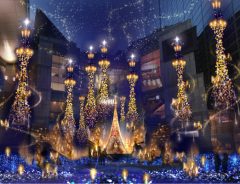
The original entrance to the station in Den-en-chofu. | Photo by George Lloyd
Den-en-chōfu: Ebeneezer Howard’s utopian garden suburb brought to life in Tokyo
- Tags:
- Den-en-chōfu / Tokyo
Related Article
-

Neon Genesis Evangelion Bar Opening Up In Tokyo Brings Second Impact Of Booze And Food
-

Tokyo Hit By Heaviest Snow Storm In Four Years And Some Actually Enjoyed It
-

Get A Taste Of Gotsubo’s Artistically Prepared Veggie Tsukemen
-

Return of the Cirque du Soleil to Japan with a Glorious Steampunk Fantasy
-

Tokyoites Can Enjoy Stunning Beauty and the Beast Themed Illuminations This Christmas
-

Kirby Cafe Returns to Tokyo with New Adorable Menu


One of the striking things about Tokyo is the lack of mansions. The city certainly has wealthy residential neighbourhoods, such as Akasaka, Aoyama and Azabu, but at least in central Tokyo, even the rich tend to have diminutive houses.
There are several explanations for the lack of 'wow' factor houses in the capital. Long after the bubble burst in the early '90s, land prices in the centre of the city are still high, and it is famously congested. In a fancy neighbourhood like Aoyama, buyers pay through the nose for a back garden, let alone a mansion.
If it's greenery you're after, Den-en-chōfu is the place to come. | Photo by George Lloyd
The long-established mania for rebuilding, and the stigma attached to ostentation also go some way in explaining why Tokyo doesn't have the stately piles you find in wealthy cities like London, Paris or New York.
In the Japanese capital, the rich might have fancy cars, shop in expensive supermarkets and dine in Michelin-starred restaurants, but even the most loaded of them are hard pushed to be ostentatious when it comes to property. Perhaps that's why in Japan, the word 'mansion' is used to describe an apartment rather than a very large house.
The closest Tokyo comes to a neighbourhood of generously-proportioned properties is Den-en-chōfu (田園調布). Situated in Ota Ward in the south west of the city, it has long been one of its most salubrious residential districts.
The atmosphere in Den-en-chōfu is quite unlike that of a typical Japanese neighbourhood - even a wealthy one like Aoyama. Walk west from the station, and you'd be forgiven for thinking you were in a small country town.
Its quiet streets, which radiate from the station like the spokes of a wheel, are lined with stately ginkgo trees, there is not much traffic and after dark, the place is very quiet. Yet it’s only 12 minutes by train from Shibuya.
Den-en-chōfu was built in the early years of the 20th century by Eiichi Shibusawa. Known as the father of Japanese capitalism, Shibusawa is said to be involved in the foundation of over 500 Japanese companies, including household names like Mizuho.
At that time, Tokyo was growing rapidly and was considered over-populated. The population had tripled over the preceding 40 years, and it had grown so quickly that little thought had been given to urban planning.
Inspired by the Garden City ideal envisaged by the British city planner Ebenezeer Howard, Eiichi Shibusawa established the Den-en-chōfu Garden City Company and in 1907, bought an outsized chunk of land near the Tama River.
He hired a well-known British town planner and asked him to design a new suburban neighbourhood along the lines of Hampstead Garden Suburb, the utopian neighbourhood that Howard had built in north London.
The seating area and fountain near the station: quintessentially British suburban. | Photo by George Lloyd
It was the Great Kanto Earthquake of 1923 that guaranteed the new suburb's success. Central Tokyo was levelled in the earthquake and in the years that followed, people began to move from the centre of the city to the western suburbs. This became an exodus after the completion of the Tōkyū Tōyoko line from Shibuya to Yokohama in 1926.
Compared to housing anywhere else in the city, the pads in Den-en-Chofu are positively palatial. It is considered a good place to raise a family and estate agents like to compare it to Beverley Hills. That might be a bit of a stretch, but Den-en-chofu 3 chome is certainly salubrious and has become the favoured haunt of business executives and celebrities.
Such is the cachet of Den-en-Chofu, it even has its own building regulations, instituted in an attempt to preserve its small-town feel. In truth, few of the neighbourhood's original houses have survived to the present day, although you can still see the odd example of Edwardian mock-Tudor and Swiss Alpine architecture dotted around the place.
The British influence can be seen in some of the newer buildings too. Some are even made of brick, a rare sight in Tokyo ever since the last of the brick structures that Josiah Condor built in the Mitsubishi 'Londontown' was pulled down in the early post-war years.
However, what's most striking about the neighbourhood's current incarnation is how discreet it has become. Whether this is a sign of the paranoia that characterises life in wealthy American suburbs or the reluctance to flaunt one's wealth that has long marked the Japanese upper class is anyone's guess, but several of the newer residences look distinctly fortress-like. It's all a far cry from the village idyll that inspired Ebeneezer Howard to build the first 'garden suburb'.
To get to Den-en-chōfu, take the Tōkyū Tōyoko line or Tōkyū Meguro line to Den-en-chofu. Note that only express and semi-express trains stop at this station.
From the station, the east exit takes you to the shops, while the west exit (to the left and up the stairs), goes to the residential district.